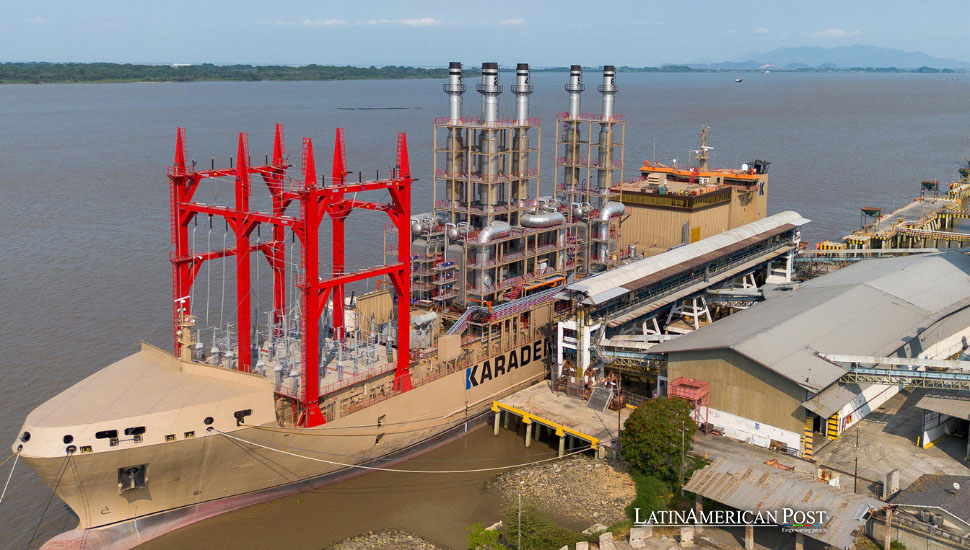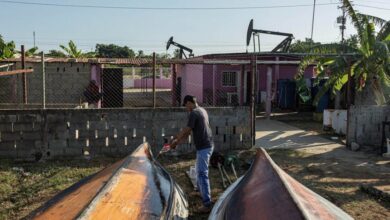Ecuador’s Energy Crisis Pushes for Floating Power Plants as Drought Strikes

Ecuador is grappling with a severe energy crisis, forcing the government to turn to floating power plants for relief. As droughts deplete hydroelectric resources, the country seeks urgent solutions to avoid further blackouts, a challenge mirrored across Latin America.
A Temporary Lifeline Amid Energy Shortage
In response to a worsening energy crisis, Ecuador has launched an urgent process to lease a second floating power plant with a capacity of 250 megawatts. The country is grappling with scheduled blackouts due to severe droughts impacting hydroelectric reservoirs. With hydroelectric power supplying the bulk of Ecuador’s energy, the drought has significantly reduced water levels, leaving the country with insufficient power generation to meet demand.
Ecuador already leased a floating power plant, the Emre Bey, which began operation earlier this week and contributes 100 megawatts of electricity to the national grid. The Emre Bey, owned by Turkish energy company Karpowership, is moored near Guayaquil and connected to the Las Esclusas substation to provide immediate relief.
However, this stopgap measure is not enough to resolve the ongoing crisis. The government is now racing to secure a second floating plant to alleviate the strain on the grid further. With power outages scheduled between 10 PM and 6 AM, the disruptions affect businesses, industries, and residents nationwide.
The floating plants, while innovative, represent a costly and temporary solution. The government’s contract for the first floating plant lasts 18 months, costing Ecuador a staggering $115 million. The deployment of these floating plants buys the government time to seek longer-term solutions, but it’s clear that the energy crisis is far from over.
The root of the issue lies in the country’s hydropower dependency. Ecuador’s largest hydroelectric facility, the Paute Hydroelectric Plant, has suffered from dramatically lower water levels, resulting in intermittent power failures. The drought-induced outages have raised alarms about the country’s over-reliance on hydroelectric power, and calls are growing louder for Ecuador to diversify its energy sources.
Drought-Induced Energy Crises Across Latin America
Ecuador is not the only country in Latin America facing a crippling energy crisis due to extreme weather conditions. Several countries in the region, which heavily rely on hydropower, are also experiencing the consequences of prolonged droughts.
Brazil, home to one of the world’s largest hydroelectric dams, the Itaipu Dam, has faced similar challenges in recent years. Droughts have caused reservoir water levels to plummet, reducing electricity generation and forcing the country to use thermal power plants to compensate for the deficit. This reliance on fossil fuels during drought has resulted in higher energy prices and carbon emissions, undermining the country’s environmental goals.
Colombia, another hydro-reliant nation, is also vulnerable to fluctuations in water availability. During El Niño weather patterns, which bring droughts, Colombia’s energy grid is often strained, leading to blackouts and rationing. Like Ecuador, Colombia has begun exploring alternative energy sources, including wind and solar power, but progress has been slow, and hydropower remains the dominant source of electricity.
In Peru, erratic rainfall patterns have also strained its hydropower plants, accounting for over half of its energy generation. Droughts in the Andes, where many of the country’s hydroelectric plants are located, have caused energy shortages, prompting the government to explore alternative sources such as geothermal and biomass energy.
These countries share a common struggle: balancing their reliance on renewable hydropower with the need for energy security during extreme weather. For many nations in Latin America, the increasing frequency of droughts, driven by climate change, poses a significant challenge to their energy systems. Ecuador’s floating power plants may provide a temporary solution, but the broader issue of energy diversification looms large across the region.
The High Costs of Energy Shortages
Ecuador’s ongoing energy crisis has affected the electricity supply and inflicted severe economic and social costs. The scheduled blackouts, implemented three times in less than a year, create widespread disruption for businesses, industries, and households.
The government reports that each hour of electricity rationing costs the country around $12 million. This financial burden adds to the already strained economy, which is struggling to recover from the global impacts of the COVID-19 pandemic. Small businesses, particularly those in energy-dependent sectors like manufacturing and food processing, are bearing the brunt of these power outages, facing reduced productivity and, in some cases, being forced to shut down during blackout periods.
The scheduled blackouts affect millions of Ecuadorians’ daily lives in the residential sector. The blackouts primarily occur at night, leaving families without electricity for basic needs, including lighting, cooking, and heating. This has also raised concerns about public safety, as many citizens fear increased criminal activity during these periods of darkness.
The healthcare sector has also been hit hard. Hospitals and clinics, particularly in rural areas, struggle to maintain operations during the blackouts. At the same time, while many more extensive facilities have backup generators, smaller clinics often do not, leaving them vulnerable to power outages that can disrupt essential medical services.
Despite implementing floating power plants, Ecuador still faces a prolonged energy crisis that is damaging its economy and social fabric. Relying on hydropower is proving to be a double-edged sword—while it provides clean energy during normal weather conditions, it leaves the country vulnerable during periods of drought. Ecuador must find a way to balance its energy needs with long-term sustainability or risk facing these recurring crises.
Renewable Solutions vs. Short-Term Fixes
While floating power plants may offer a short-term solution to Ecuador’s immediate energy crisis, the future of energy in Latin America will require more sustainable and reliable alternatives. The region’s heavy reliance on hydropower has proven to be a vulnerability in the face of climate change, with increasingly frequent droughts threatening the stability of electricity supplies.
One promising area of development is solar energy. Countries like Chile have already invested significantly in solar power, taking advantage of the country’s vast Atacama Desert, one of the sunniest places on Earth. Chile is now one of the leading countries in Latin America for solar power generation, and its success offers a model for other countries in the region to follow.
Wind energy is another area where Latin America is starting to make strides. Brazil has become a regional leader in wind power, with large-scale wind farms in the northeast of the country providing a growing share of its electricity. As the technology becomes more affordable, other countries like Argentina and Uruguay are also expanding their wind power capacity, offering an alternative to the over-reliance on hydropower.
Ecuador’s government has recognized the need for energy diversification. The country is exploring investments in geothermal energy and biomass, which could help reduce its dependency on hydroelectric power. Additionally, Ecuador’s push toward developing offshore wind farms could significantly boost its renewable energy capacity in the coming years.
The challenge for Ecuador, and for other Latin American countries facing similar issues, is to balance immediate energy needs with long-term sustainability. Floating power plants and other short-term fixes may provide relief during crises, but they do little to address the underlying vulnerabilities in the region’s energy infrastructure. As Latin America continues to grow, its energy demands will only increase, making the transition to renewable and reliable energy sources more critical than ever.
Also read: Revolutionary Technological Investment Boosts Ecuador’s Circular Economy
Ecuador’s energy crisis is a stark reminder of the challenges that Latin American countries face as they grapple with the effects of climate change on their power grids. While the use of floating power plants offers a temporary solution, the long-term answer lies in diversifying the region’s energy sources and investing in renewable alternatives like solar and wind power. As droughts continue to impact hydropower generation across the region, Latin America must adapt to ensure its energy future is sustainable, secure, and resilient.




